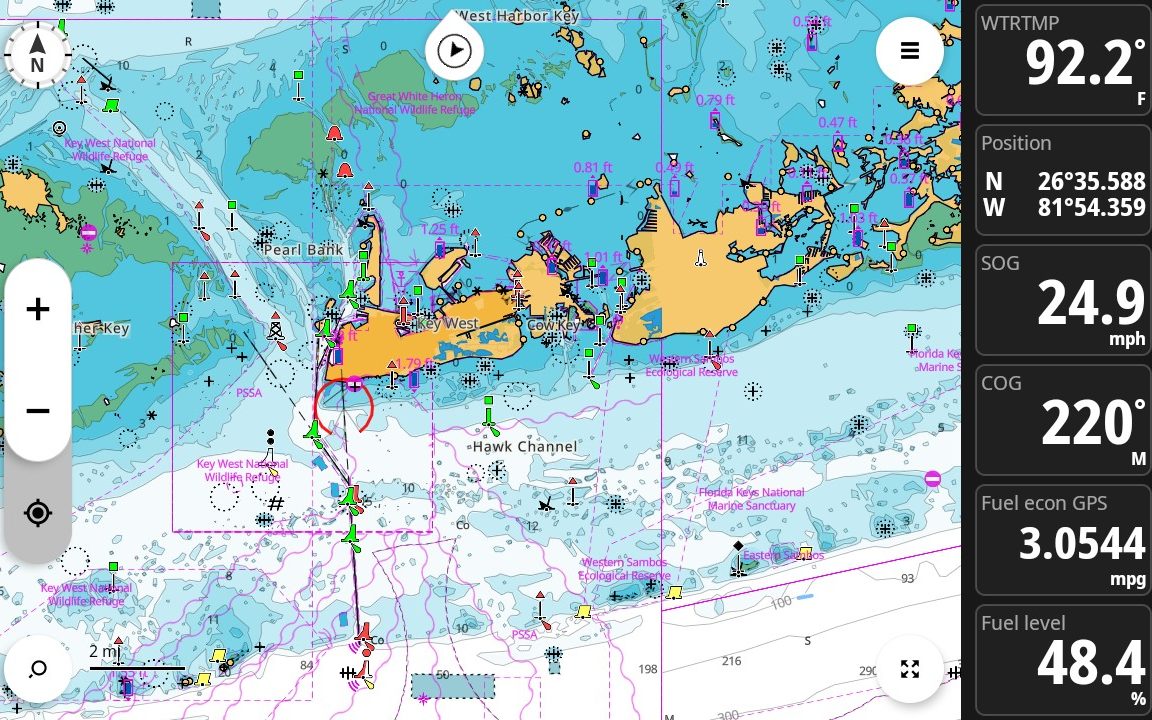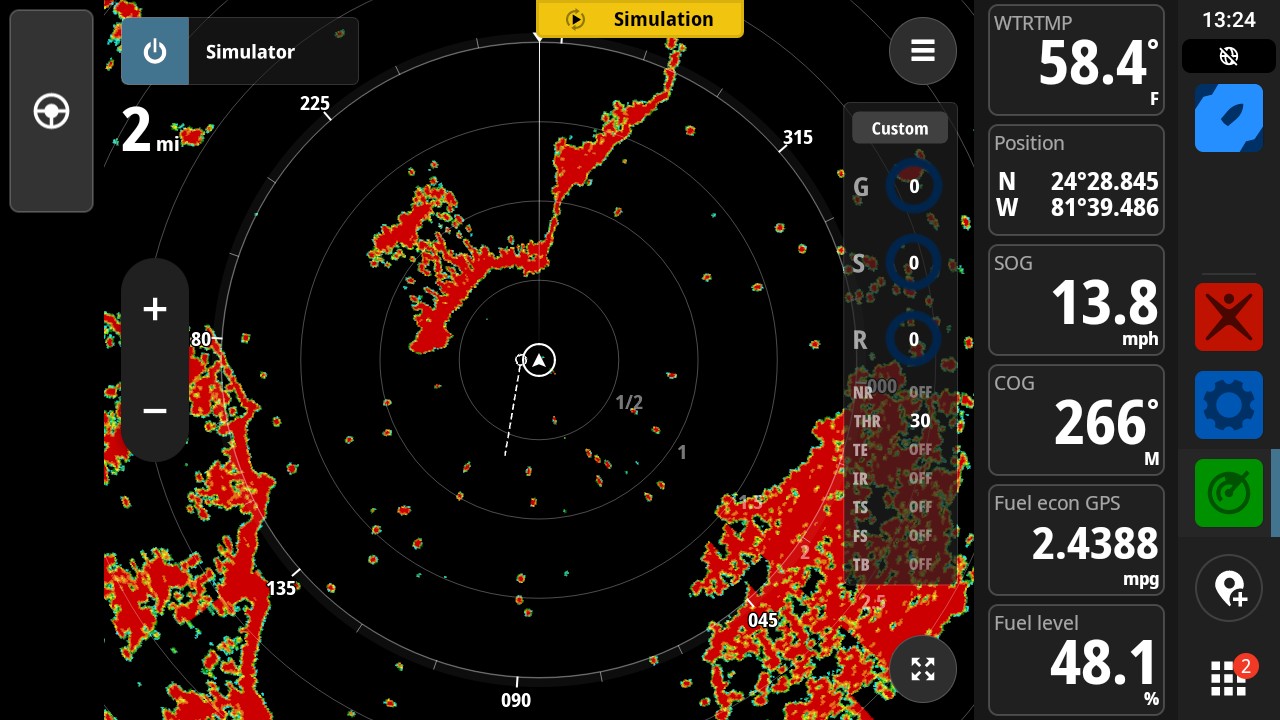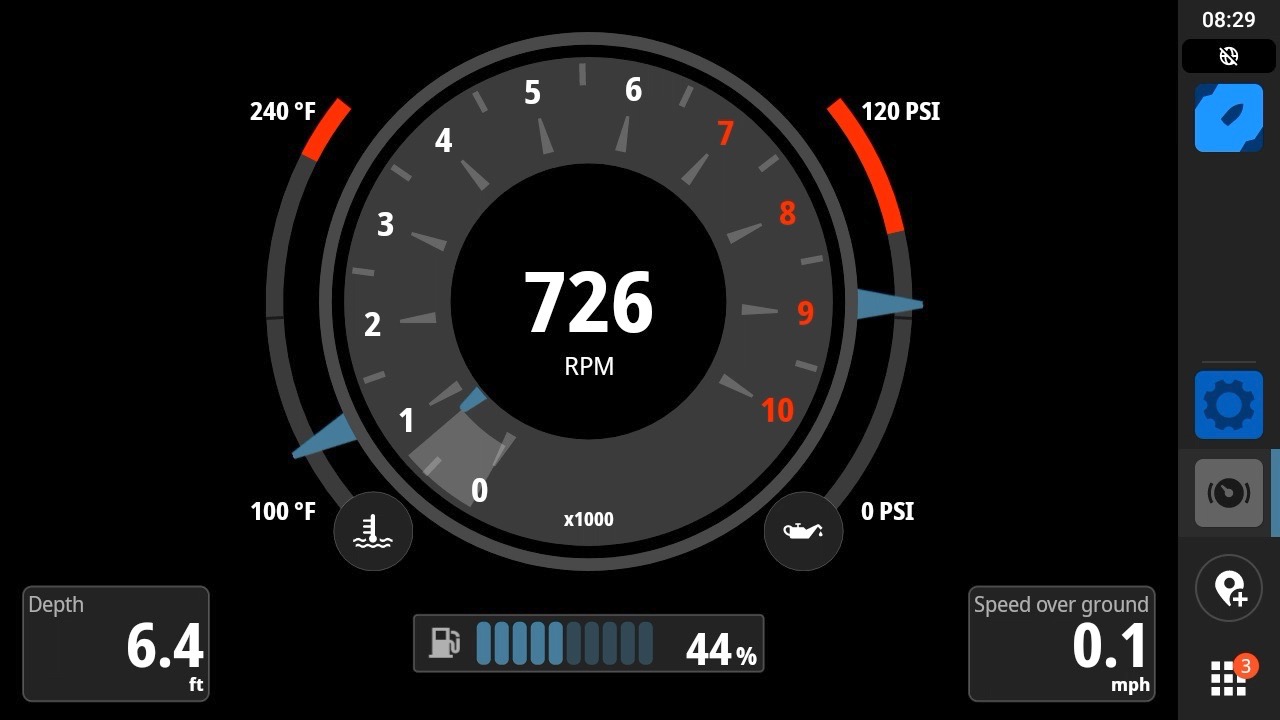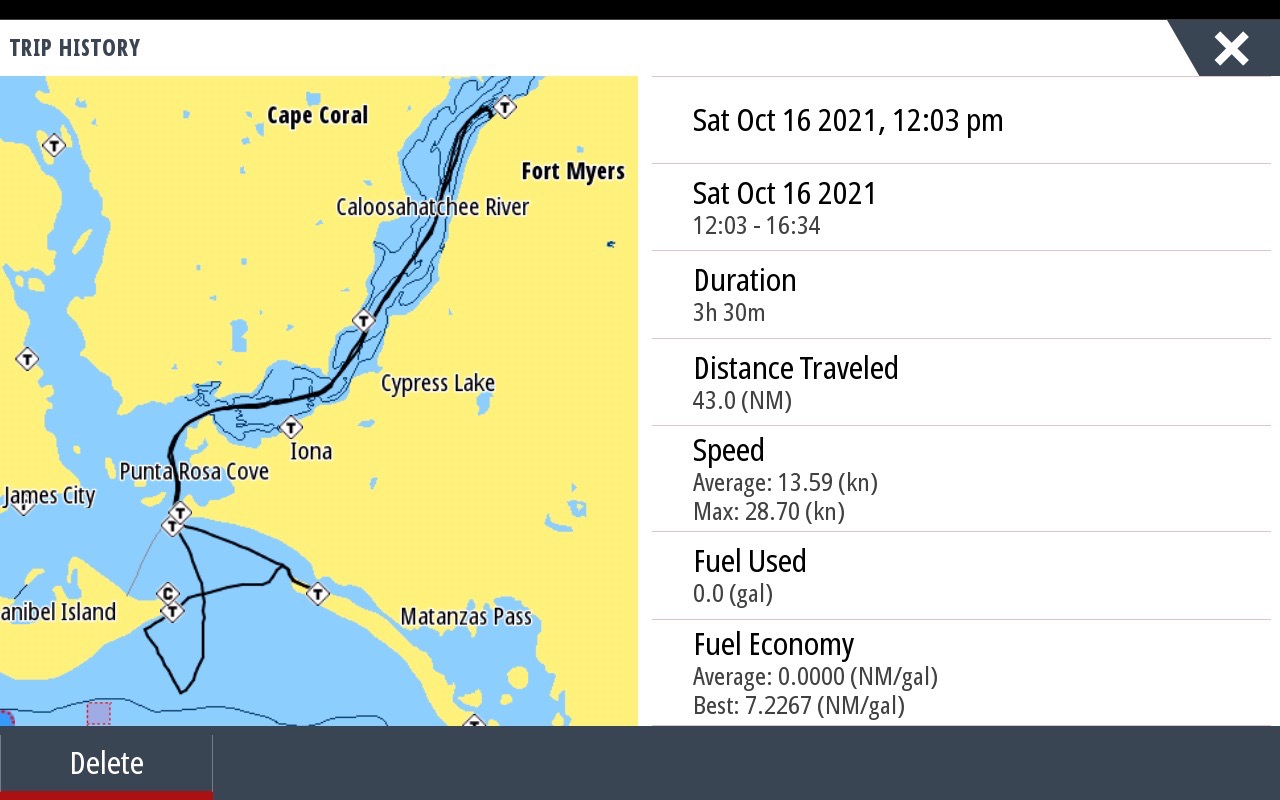Simrad NSX, an impressive debut of Navico’s next-generation platform

The Simrad NSX may be a value-oriented chart plotter in Simrad’s lineup but “value model” doesn’t tell the story of how important NSX is to Simrad’s, and Navico’s, future. NSX is the first MFD running on Navico’s Neon operating system (although B&G’s Nemesis was the first Navico hardware to run it). I’ve been using an NSX in Panbo(at) for the last several months and I’m pleased to report NSX is an upgrade from the Simrad Go it replaced in nearly every dimension. If this is Navico’s future, the future is bright.
The NSX is available in 7-inch, 9-inch, and 12-inch models. The 1,024×600 pixel, 7-inch model lists for $1,049, the 1,280×720 pixel, 9-inch model lists for $1,449, and the 1,280×800 pixel, 12-inch model lists for $2,749. All models include a sonar sounder module and the all new C-Map Discover X charts.
Using NSX

As I noted in my quick entry about the start of testing, the overall visual impression of NSX and Neon is really positive. Nearly every screen is attractive and intuitive. Plus, the X Generation charts are, at least to my eye, noticeably more attractive than the C-Map charts they replace. I’ve long considered Navionics’ visual presentation the gold standard for charts and I’d say the X Generation charts are equal to, or even better than, Navionics.
But, my positive impression of NSX isn’t just about appearance. It’s really about the way the system works, responds to your input, and gives you the information you’re after. Let’s be honest, technology has gotten to the point that MFD selections aren’t about which ones can do the job and which ones can’t. Every chart plotter or MFD on the market has more capabilities than we recreational boaters are likely to ever need. So, as new equipment comes to the market, it’s really about more intuitive and easier use as well as advanced functionality.
NSX slots into Simrad’s lineup in roughly the same position as their Go line of chart plotters. But, it’s not a one-for-one replacement. NSX is a little more expensive, and currently doesn’t come in a five-inch version, but from what I’ve seen it’s faster, has significantly more advanced networking features, uses IPS displays and generally feels higher-end.
Charts

I’m not an expert on the science and technology of presenting charts electronically. But, I do get to see lots of different charts and have formed my own opinions about what I like. To me, Generation X charts feature an attractive color scheme, easy-to-read fonts, and scale nicely. I rarely feel like the charts are overly crowded with too much detail that ends up confusing the eye.


The gallery above shows the NSX 9 with C-Map Reveal X charts on the left and a Simrad Go12 displaying C-Map Insight Pro charts on the right. To my eye, there’s nearly no comparison in both the visual appeal and clarity of the two charts.

There are two versions of X Generation charts: Discover X and Reveal X. According to the Simrad website, Discover X comes bundled with the current NSX chart plotters. Reveal X adds a shaded relief layer and satellite imagery.

Both flavors of charts bring a lot of functionality; too much to talk about all of it here. But, it is worth highlighting a few of the bigger benefits I’ve found. First and foremost, I appreciate that autorouting isn’t tied to a subscription.

Using NSX, I’ve often found the combination of chart presentation and Neon’s interface makes it easier to accomplish familiar tasks. Bringing up the chart data inspector on an ATON reveals familiar information. But, the presentation of the information is, to my eye, easier to read at a glance.
Currently, the X generation charts are exclusive to NSX. Additionally, all NSX models ship with Discover X charts. For coastal North America you could also purchase Discover X charts without an NSX for the US and Canada for $149 compared to $249 for Reveal X coastal. But, I don’t think there’s a way to upgrade from Discover X to Reveal X besides buying all new charts.
Route planning

It’s possible that Neon’s handling of route planning is its greatest strength and also the best illustration of the polished, intuitive user interface.
First, a caveat: I’m going to talk quite a bit about auto-navigation. Across all the products I evaluate, I continually see improvements in auto-nav, but that’s in large part because there’s plenty of room for it. Automatic navigation planning on the water is not nearly as mature as automobile navigation. Currently, it’s a very useful distance planning tool and can make planning in straightforward areas much faster. But, it’s not a replacement for an experienced mariner making careful navigation plans. So, please verify anything your MFD plans before following it. Okay, I’m off my soap box now, I promise.
Neon makes switching between auto-planned routes and manually planned extremely easy. As you build a route, each leg shows on the right side of the screen. For auto-routed legs, just tap the route symbol on the right side of the leg and it will switch to a direct route. For legs not auto-planned, tap the leg, tap the route symbol on the right and it will be auto-planned.

Each auto-routed leg will be color-coded by depth: blue for safe water, yellow for shallow water, and red for water that’s too shallow. Tapping those color-coded sections will bring the start of the section into focus.
The video above walks through the process of planning a route. The method I’m using to record videos on NSX slows it down a little so real world performance is better than what you see in the video.
Sonar




I’ve been testing the NSX with Simrad’s 3-in-1 Active Imaging transducer. The 3-in-1 AI mounts on Panbo(at)’s relatively small and congested transom. Between the center-mounted engine and the Zip Wake trim system, there’s not much room for the transducer. The main tradeoff I’ve had to make is that the transducer comes most of the way out of the water on plane, as a result, it loses the bottom at speed.
Sonar functionality seems largely unchanged from what I experienced with the Go. But, I had little quarrel with the Go’s sonar. The screenshots above show performance on a choppy day. Panbo(at) has a satellite compass providing, among other data, pitch and heave data that would make it possible to correct, but that’s a lot to ask of a brand new platform. Especially from a value-focused model.
Radar


I haven’t had the opportunity to get on the water testing with NSX and a Halo radar unit yet. I’m planning some head-to-head testing of the current crop of solid-state enclosed domes, however, that work isn’t done yet. I have used the radar app with the simulator as well as with a radar unit connected but sitting outside my shop on land.
I’ve noticed that the radar app seems to be a little bit slow to respond to user input. I expect this will get better over time as Navico optimizes the functionality. At first, I thought this might have been because I was using simulated data but even with the actual radar unit I saw the same performance. Since I tested the Go and Halo20, I’ve had an affinity for the radar scope appearance on NavicoOS (or NOS, Navico’s outgoing operating system). To me, it reflects big-ship radar in appearance while delivering a bunch of information. Neon’s radar app has a more modern appearance and makes adjusting settings easier, but it doesn’t have the same shippy feel.
Instruments








Neon builds on the excellent instrument functionality in NOS. For years I wondered why it wasn’t possible to arrange gauges on an instrument page via drag and drop. Touch screen interfaces are made for this kind of work. It seems Navico agreed since in late 2020 they introduced that ability in NOS and carried it forward into Neon. Like everything else in Neon I think the new gauges are a little more attractive and I find the drag and drop interface a little more responsive on NSX than I did on the Go. Additionally, the eight pre-defined pages shown above provide a lot of information and probably cover most needs.
Performance in this video is also reduced a little bit because the processor in the NSX is busy recording the video. Instrument pages I’ve created without video recording have gone a little smoother.
Trip intel


One of my favorite features of NOS is Trip Intel. Trip Intel is NOS’ automatic trip recording functionality. As soon as the vessel starts moving Trip Intel displays a prompt with choices to start a new trip or continue the existing one. The result for me has been that I have nicely categorized and easily viewed records of every trip the boat took with the Go12 installed.


NSX doesn’t have the same functionality. It has an intuitive and easy-to-use track manager, but the tracks will span longer periods of time. In my use, I found the track manager an inferior solution to Trip Intel. There are some hints of trip functionality still buried in some of the data so I have hope Trip Intel may make a return, but for now, I miss it.
App

Although Navico intends to add functionality to the Simrad app, right now it’s very much a one trick pony. The only thing you can do from the app, besides getting version, model and serial number information, is upgrade the software on the device. In the future, Navico intends to support screen mirroring, chart updates, and more.
Other features


The Simrad product manager who first showed me NSX at the Miami Boat Show was very proud of their night mode. I recall finding his focus on night mode a little odd but he kept telling me I wouldn’t even need to turn down the brightness of the display. In practice, I’ve found myself dimming the backlight a little, but even without dimming, night mode is effective at preventing searing your eyeballs.



Safety features don’t always get top billing and probably don’t sell too many units. But, as I’ve learned myself, in an emergency everyone reacts differently. We can all forget things we know well, so it’s very helpful to have them prominently displayed and available.
When the user taps the man overboard icon on the home screen, the screen above is loaded. The MOB screen includes step-by-step instructions on how to hail for help including your vessel name, callsign, and current position. While this is likely to be helpful for the operator of the boat, it could be invaluable if the call is being made by a passenger.
Final thoughts
Simrad’s NSX is cost effective, intuitive, attractive, and highly functional. That’s an impressive list of attributes it has going for it. But, it isn’t perfect. There’s some functionality not yet implemented and I’ve certainly seen some app crashes and other reminders this is a new platform. Before NSX, it had been a long time since we saw major new developments from Navico. Based on what I’ve seen in NSX, they were quiet doing a ton of work to launch a new platform and they’ve done a good job of it thus far. I’m excited to see Neon based successors to other products in the Navico lineup.













Thanks for the review. When you write MFD reviews please tell which software version it’s running. Especially in the early days the performance difference between different software versions can be huge.
I have not noticed any lag in the radar user interface. I’ve been using it with an open array Halo. The weekend before I used GO12 XSE instead of NSX and I was frustrated over the lag. I was running both units in a large system with NSS12 Evo3S, radar, several sounder modules and a large number of NMEA 2000 devices. NSX is slower than Evo3S, but i wasn’t frustrated like I was when using GO XSE. Normally I’m running a NSS12 Evo3 in addition to the Evo3S.
The back light synchronization of NSX is working with the rest of the Simrad units and devices. If I dim from Evo3S or the autopilot pilot control panel also NSX changes. The back light levels are similar to Evo3S. The product manager which thinks it’s not necessary to dim the screen have limited if any experience with night boating. I fish from the evening to morning and In the night I need to dim everything down to the lowest back-light levels. Some people will probably be frustrated that it takes 15s to change between day and night mode.
Abbor,
This review was done with build number 1.1.170. Midway through my review, I received the updated version but everything was retested against 170. I’m glad to hear your data point of no lag in radar. Hopefully, when I get out on the water with the Halo 20+ installed I’ll have the same experience.
-Ben S.
Always one step behind Garmin who keep leading with best user experience, good app and top notch fish finder
User interface preferences are very subjective. When the new Linux based NOS Lowrance and Simrad user interfaces were introduced in 2014 I know a lot of people considered this the best and most intuitive in the industry. They also got very positive feedback from the visitors at the boat shows trying the units. I think the NOS UI has hold up well over the years with minor changes and advancements.
NSX which is running Android based Neon OS is Navico’s new platform. It looks very nice and it has a lot of guides assisting the user with performing different tasks. This will be a huge advantage for less frequent users when they should perform more advanced tasks.
Garmin UI might be easy to use when only using the most frequently used settings, but as soon as you want to do more advanced tasks it’s a nightmare to find where Garmin has “hidden” the menus. For me as an engineer it’s no logic in where Garmin’s advanced functionality can be found.
I’m also trying out an NSX 12 with my network, which has an NSS Evo3 9, Halo 24+ HS40B, NEP2 , Poco light controller and Lowrance fuel flow sensors and several transducers. The boat is a 96 Sundancer 330 with twin carburated 350s.
I put the NSX in the place of my NSS ev03 12″ plotter. it started out fine, but now the NSX hangs up and returns to the “I Agree “screen constantly after the software update.
I see Abbor has an evo3 and the nsx unit working together so it must be somewhere in the network. The NSX works fine if I power off the evo3, the evo3 works fine either way.
The odd thing is that the NSX screen indicates I need to do a Seratrail for4 the radar, but it doesn’t give any info on what to do.
I have the NSX12 installed on a customer boat with a Halo 20+, the plotter works fine with the radar, but it also say I need to complete a seatrial for the radar.
Do you have any info on the radar seatrial?
Scratch the Sea-trial question, I found a good video that covers the topic
https://www.youtube.com/watch?v=mWTjVBqLOfo
Is there any talk of updates coming to the B&G range, particularly to cover off sailing functions?
Ray, in the long term I think Navico intends to bring out Neon based products across all their lines. But, the big question is probably time frame and I don’t have any insight on that.
-Ben S.
How is it that our phones can have such amazing resolution but we’re still looking at 1990’s vintage resolutions on navigation plotters?
The iPhone 13 is now a 2778 by 1284-pixel resolution OLED display at 458 ppi, yet we are expected to put out thousands for 1280×800?? That’s sub HD! SURELY they can do better. Ask why people are using tablets on deck.
This a big part of why I continue to use a laptop for navigation and the Vulcan plotter as an instrument repeater. For true navigators who work problems like those found on the USCG test, these are insufficient for the task.
JoeSailor, It seems you’re over-focused on resolution. I think you’re drawing some comparisons that aren’t quite apt. First and foremost with display resolution is the distance you’re going to be from the display as well as the size of the display. MFDs are typically used at a greater distance than a phone. Consider that, in order to appreciate the resolution of a 55″ 4k TV, the optimal viewing distance is less than 4 feet (https://stari.co/tv-monitor-viewing-distance-calculator). All that extra resolution is wasted unless you get your nose almost close enough to touch the display.
Additionally, the displays in MFDs are optimized for sunlight visible brightness while dissipating the heat of the direct sun. Additional resolution runs against these goals.
Finally, the 9″ version of an NSX starts at $1,450 and the 7″ starts at $1,050.
Oh, by the way, what’s the resolution of the laptop display you use for navigation? I’d hazard a guess that it isn’t much higher pixel density than the 167 PPI of the 9″ NSX.
-Ben S.
Not a very happy nsx9 owner here. Very difficult to ‘intuitively’ follow and a struggle to learn what should be SIMPLE tasks!!! Like how to get screen to follow boat icon w/o having to scroll display in chart mode! DAMN! Many other nuances! But hopefully ‘promised software updates’ will FIX the nsx9 shortcomings!!!!! Until then – bummed!
Interesting, overall, I’ve found the NSX to be one of the most intuitive MFDs I’ve used. To get back to following the boat, you just press the cross arrow and target I’ve pointed out with an arrow. Every new OS comes with some adjustments, but (for me) NEON has been particularly intuitive.
I’d say we’ve learned one person’s intuitive, is another person’s confusing.
-Ben S.
…. thank you! I will continue to try and be a more ‘intuitive’ thinker !
lol ~
I just reread my comment and noticed I didn’t say what I really meant to say. I think it’s interesting that an interface I find intuitive you find difficult to adjust to and use. It’s a demonstration that one person’s intuitive is another person’s confusing. It speaks to the challenge for user interface designers and the importance of trying out several different MFDs before making a decision. I certainly hope you get used to NSX and find it works for your use.
-Ben S.
I’ve been on the coastal waters recreational pontooning (not a fisherman) since the early 2000’s. This is my 1st MFD experience. Researched them all. Most fishermen here use the Garmin. I just repowered from a 1996 FORCE 75hp to a 2022 Suzuki 140 ‘drive-by-wire.’ Read lots of good things about the Suzuki and SIMRAD interfacing nicely, which it does. Initially bought the GO9. The NSX was moe than I wanted to spend. After messing around w/ the GO9 for a while and continued research I decided to suck it up and trade up to the NSX9, mainly because of the NEW technology integrated. I felt it would be the better investment for the long term, kinda like my decision on the ‘drive-by wire’ LOVE LOVE IT!!!!! Hopefully, I will be able to figure out the “intuitive’ angle of the NSX9 and can come back SOON and tell you the same about the NSX as I share about the DF140bg!!!! Fingers crossed. Right now I cannot figure out how to get the track history from my NSX9 to my mobile SIMRAD/C-MAP mobile device app to sync up. Gotta be an EASIER way to do ALL of this!!!! I am ready for SIMRAD to make much-needed software updates to the NSX series SOON! THANKS for your previous feedback!!!! Means a LOT!
Thanks for the article, I was about to purchase the GO 7” for my tender but am now wondering if the extra $300-$400 for the NSX 7” is worth it. Being it’s on a tender I only need the chart plotter and depth sounder for when out exploring. In this application would you recommend the NSX over the GO?
William, I think the NSX is a huge step forward from the G0 line in nearly all respects. It’s more powerful, and in my opinion, more intuitive. I’d definitely spend the extra money for the NSX. But, I’ll remind you, I got into marine technology because it’s a topic I’m passionate about, so my answer is skewed by that.
-Ben S.
Ben, thanks, I’ll be ordering my 7” NSX soon.
I was going to install some NSX units (pair of 12″and a 9″) for a customer.
And I was confused why and severely disappointed that they are not actually networkable? They will not share sounder images only depth between units same with radar. And limited transducer compatibility.
The new platform is intriguing but on my opinion not ready for customers as they don’t have the software sorted out.
(Also not capable of networking with NSS platform)
My customer returned and got NSSevo3s .
I’m a new user for Simrad NSX 3009, with 9″ screen. Does any one know how to leave a track and then use that track in the future to help guide you the same way? Thanks!
It’s really easy. Open the tracks app, and select ‘New Track’. If you want to have it always start a new track turn on Auto Trip Detection in the menu.
When using the chart app you can select a track on the chart and choose to turn it into a route via the sidebar options.
Hi Ben
I installed a complete new all B&G navigation system, instruments, autopilot, radar and two Zeus S (9 and 12). The MFD’s are fed ethernet data via a Nep2 ethernet splitter. I have one question, as the Zeus S (same as the Simrad NSX) only has one Micro SD card slot how can I introduce a second SD card as I’m planning a trip which will span two cards? Any ideas? Thanks
Fit an MI-10 card reader which plugs in to the USB port – this will give you two extra slots. Note only for 9 & 12″ models. 7″ has no USB, at least externally ;-).
Hi there
Thanks for the reply. I did consider this but was reluctant to buy it as the specs compatibility doesn’t mention the Zeus S, only the other Zeus models. This could be because the MI-10 documents were produced well before the Zeus S range came out. Still, think now it’s worth a try. Thanks again for your help. Cheers
I don’t think MI-10 is supported yet. I read a post at the THT forum a couple of days ago were someone hoped for MI-10 support for NSX in the next software release.
With two Zeus S units hopefully one chart card can go in each unit. But I have one NSX and two NSS Evo3S in my system and since charts are not compatible between Neon and NOS based unit I can’t check if if chart sharing is supported for NSX yet. But since you have two Zeus S units you can check if you can see the charts at your chart card at both units, if you can we can assume you can have one chart card in each unit.
Hi Abbor
Thanks for the information.
I have both Zeus S plotters connected via a NEP2 Ethernet network. The charts in the 12in and is also displayed on the 9in. I’ll put the second card in the 9in. Theoretically this should work, the downsides being that I have to have both plotters on and also change the source, not ideal but should work. Will update. Cheers